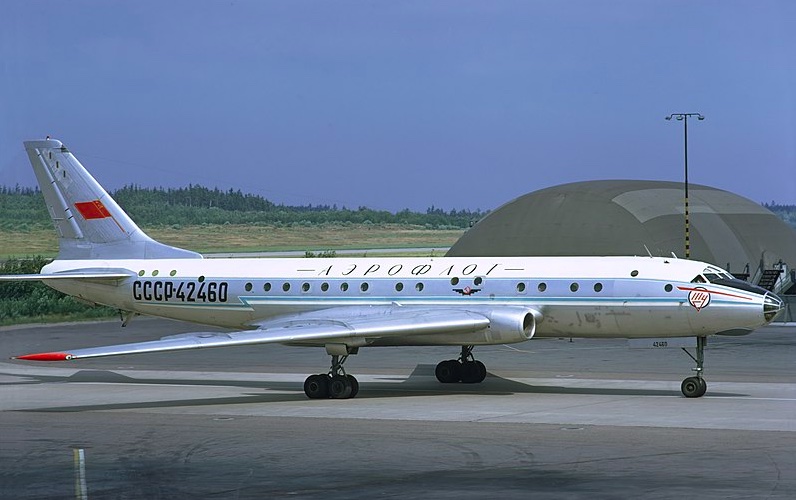Over the years, aviation safety has improved drastically. Manufacturers and regulators have learned from past events to make and certify aircraft that are safer for everyone. However, let's take a step back in time and analyze three of the most dangerous airliners that took to the skies.
As a point of relief for the skeptical flyers, none of these aircraft types are in passenger service today.
De Havilland Comet

The Comet entered service in 1952 with the British Overseas Airways Corporation (BOAC). It was the world's first jet-powered airliner that, upon entering service after years of war, showed the world that Britain continued to be at the forefront of civil aviation.
Unfortunately, one of the Comet's biggest issues became apparent not long after its introduction into service. The plane quite literally would not take off.
On October 26th, 1952, a BOAC Comet overran the runway at Rome Ciampino Airport. Reportedly, the plane would not lift off the ground despite its nose being pitched up after reaching rotation speed. The Comet eventually came to a stop and everyone survived though the damage sustained by the plane caused it to be written off.
Not even four months later, a Canadian Pacific Air Lines Comet suffered a similar issue although it led to a far worse outcome.
The brand-new aircraft was registered C-FCUN and named "Empress of Hawaii". It being delivered to Canadian Pacific in Sydney from where the carrier would launch Comet service between Sydney and Honolulu.
The flight crew made a refueling stopover in Karachi, Pakistan and despite having been trained on the Comet, neither pilot was trained to conduct a night takeoff with the plane fully loaded.
Therefore, as the plane accelerated through 85 knots, the pilot raised the nose too soon creating more drag on the wings resulting in decreased airspeed. The Comet sank back onto the runway but soon overshot and crashed into a drainage ditch. This tragic accident became the world's first involving passenger fatalities on a commercial jetliner.
The Comet continued to suffer from fatal incidents in the years that followed. These ranged from structural failures to explosive decompressions. Of the 114 Comets that were built, 25 were involved in such incidents with seven of those incidents occurring within the first two years following the Comet's introduction to service.
These issues stemmed from a lack of experience in the manufacturing techniques used by De Havilland. Eventually, certain aspects of the Comet that contributed to the various crashes were fixed for later models. However, the deadly reputation of the plane could not be overlooked.
Tupolev Tu-104

The Tu-104 was another one of the first commercial jetliners to enter service. During the pause in Comet operations due to reasons outlined earlier, the Tu-104 ended up being the world's only jet airliner for a brief period of time.
However, it did not take long to realize that this plane was not particularly safe. The TU-104's controls were heavy and the plane was unstable. The aircraft had highly swept wings that frequently caused the plane to stall. Such a high wing sweep was not meant for a commercial airliner.
Furthermore, the plane tended to pitch up violently or enter an uncontrollable dive after stalling. To avoid stalling, pilots would fly the landing approach at 50 km/h (around 25 knots) faster than the intended speed which caused problems of its own.
In 1958 alone, three Tu-104s were lost in accidents. The years that followed saw a steady rate of 104s crashing. From its introduction, 32 TU-104s were involved in hull-loss accidents before the plane was officially withdrawn from commercial use.
The Russian military was among the last to use the aircraft type. They stopped flying the Tupolev 104 in 1981 after a Soviet Navy example crashed due to improper loading of cargo.
McDonnell-Douglas DC-10

Ah yes. This wouldn't be a "dangerous planes" article without mentioning the DC-10.
The DC-10 was developed after American Airlines asked McDonnell Douglas for a long-haul aircraft smaller than the 747. This led to the company bringing to fruition the idea of a tri-holer (three-engined plane) around the same time as competitor Lockheed Martin.
Eventually, American Airlines ordered 25 DC-10s in February of 1968. The aircraft's first flight was in August of 1970 with it entering revenue service with American Airlines the year after.
Unfortunately, not even a year after American Airlines began operating the DC-10, the type suffered its first accident. One example was climbing out over Ontario, California at 11,750 feet when the rear cargo door blew off. The resulting explosive decompression caused the cabin floor to collapse.
The decompression also caused multiple control cables to sever, including those for the rudder and number two engine (the one in the tail). Thankfully, the crew was able to maintain control of their aircraft and make a safe landing.
It's worth noting that the DC-10 was the first airliner produced after the McDonnell and Douglas aircraft corporations merged. The management from McDonnell directed that the plane be produced on a tight budget. This saw technology being recycled from the DC-8 and various aspects of production of the DC-10 being contracted to other companies.
This included the production of the fuselage that was contracted to Convair, who was forbidden from directly contacting the FAA even over safety concerns.
Hold on, two aerospace companies merging and then facing controversy over building their planes for cheap? Where have we heard that before...
The rear cargo door failure issue was later addressed. It was found that a locking mechanism to the door was added along with an inspection window.
Despite the issue being tackled, a Turkish Airlines DC-10 crashed shortly after leaving Paris Orly in 1974 with all 346 onboard perishing. This aircraft too had suffered a rear cargo door failure, but had been incorrectly recorded as having received the modification to prevent the issue.
In total, 32 DC-10s would be lost in accidents with other issues, such as engines falling off as in the tragic case of American Airlines 191 in 1979.
A total of 386 examples of the DC-10 were built. The various issues that affected the DC-10 in its early years were eventually addressed with many examples continuing to fly well into the 21st century.
However, the early string of accidents that afflicted the aircraft type gave it its deathly reputation.
Comments (0)
Add Your Comment
SHARE
TAGS
INFORMATIONAL Most Dangerous PlanesTupolev 104Tu-104De HavillandCometMcDonnell DouglasDC-10McDonnell Douglas DC-10dangerous planes in the worldRECENTLY PUBLISHED
 Learjet Owned By Vince Neil Crashes Into Gulfstream Jet, 1 Fatality Confirmed
On February 10th, around 14:30 local time, a Learjet private jet aircraft crashed into another private jet after landing at Scottsdale Airport (SCF) in Arizona.
NEWS
READ MORE »
Learjet Owned By Vince Neil Crashes Into Gulfstream Jet, 1 Fatality Confirmed
On February 10th, around 14:30 local time, a Learjet private jet aircraft crashed into another private jet after landing at Scottsdale Airport (SCF) in Arizona.
NEWS
READ MORE »
 Seattle Plane Strike 2025: Japan Airlines and Delta Collision Raises Safety Concerns
Seattle-Tacoma International Airport saw a concerning incident on Wednesday morning when a Japan Airlines (JAL) plane clipped a parked Delta Air Lines jet while taxiing. Thankfully, no one was injured, but passengers described the collision as a frightening experience.
NEWS
READ MORE »
Seattle Plane Strike 2025: Japan Airlines and Delta Collision Raises Safety Concerns
Seattle-Tacoma International Airport saw a concerning incident on Wednesday morning when a Japan Airlines (JAL) plane clipped a parked Delta Air Lines jet while taxiing. Thankfully, no one was injured, but passengers described the collision as a frightening experience.
NEWS
READ MORE »
 Ethiopian Airlines Expands Cargo Fleet with New Boeing 777 Freighter
Ethiopian Airlines has expanded its cargo fleet with a brand-new Boeing 777 Freighter, registered as ET-BAB (MSN 68140). The aircraft was delivered directly from Boeing’s factory in Everett, Washington, USA, and landed at Addis Ababa Bole International Airport at 3:41 PM (GMT+3) on Wednesday, January 22, 2025.
NEWS
READ MORE »
Ethiopian Airlines Expands Cargo Fleet with New Boeing 777 Freighter
Ethiopian Airlines has expanded its cargo fleet with a brand-new Boeing 777 Freighter, registered as ET-BAB (MSN 68140). The aircraft was delivered directly from Boeing’s factory in Everett, Washington, USA, and landed at Addis Ababa Bole International Airport at 3:41 PM (GMT+3) on Wednesday, January 22, 2025.
NEWS
READ MORE »





